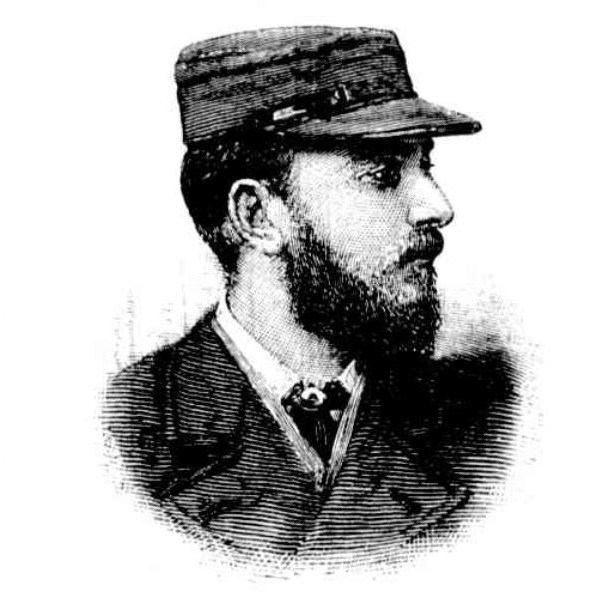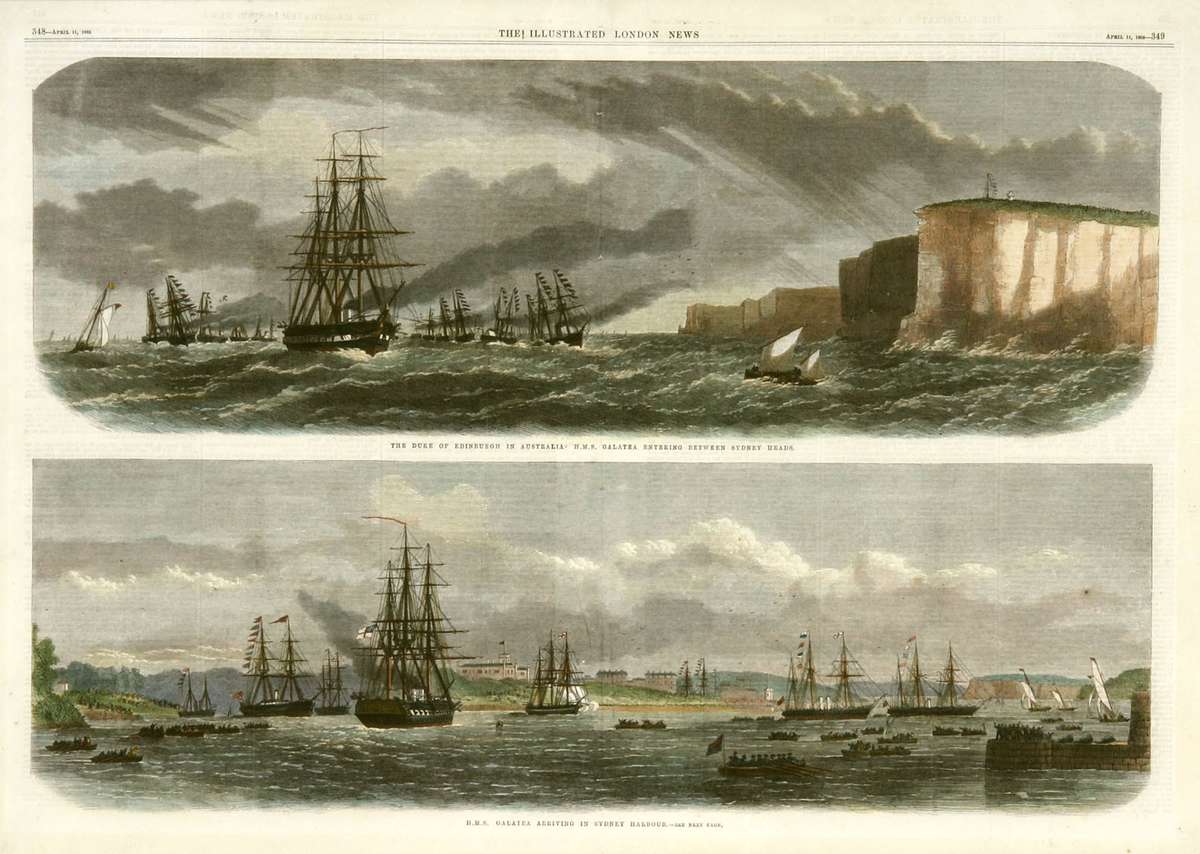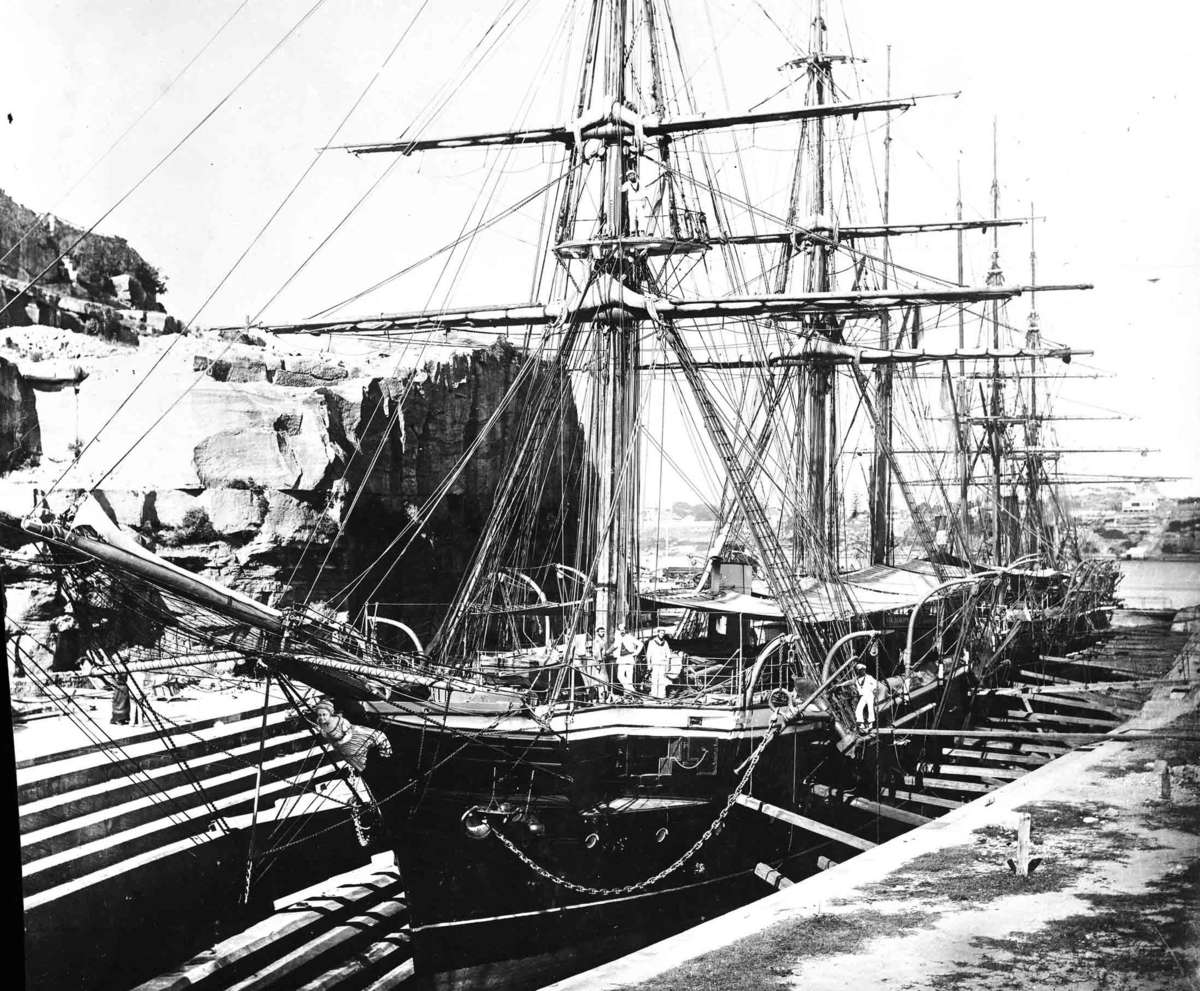
This story was inspired by a monkey. Lately I’ve noticed that in addition to stories being discovered within the museum’s collection, some of our wonderful followers have been coming forward with stories of their own and relating it back to the museum’s collection. Enter Flickr user beachcomberaustralia and his seafaring relative, Lieutenant William Henn – America’s Cup sailor and proud owner of Peggy the monkey.
William Henn was born in 1847 in Dublin, Ireland. At 13 years of age, he joined the Royal Navy (RN) as a cadet on HMS Trafalgar. From 1862 to 1866, he served as midshipman on the steam frigate HMS Galatea, at the time one of the fastest ships of the RN. William left the vessel a few months before the Duke of Edinburgh, Prince Alfred, took command. The Duke went on his famous world tour arriving at Glenelg, South Australia on 31 October 1867 and eventually in Sydney on 21 January 1868. The Duke’s time in Sydney is best remembered for the failed assassination attempt on his life during a day spent picnicking at the suburb of Clontarf.

The Duke of Edinburgh in Australia, 1868
ANMM Collection

Photograph of a photograph of HMS Galatea in Cockatoo Island dry dock, Sydney in 1870
Samuel J Hood Studio
ANMM Collection
Following William’s service on Galatea, he rose to the rank of sub-lieutenant on HMS Daphne, serving in the East Indies and along the African coast. He retired from the RN in 1874 at the rank of Lieutenant and decided to pursue his real passion – sailing. William had built his first boat in 1870 in which he cruised along the Irish coast. After his retirement he purchased the cutter Minnie. For the next two and a half years he made this vessel his home and sailed the Mediterranean. Around this time he met his wife, Susan Cunninghame-Graham, who was a keen and talented yachtswoman. They purchased the 80-ton yawl Gertrude after they married in June 1877. They sailed Gertrude together for the next seven years.
![Deck of Galatea, 1880-1899 Library of Congress, Prints & Photographs Division, Detroit Publishing Company Collection, [reproduction number, LC-D4-4904]](https://s3-ap-southeast-2.amazonaws.com/anmm-data/blog/2013/09/04/galatea-via-library-of-congress.jpg)
Deck of Galatea, 1880-1899
Library of Congress, Prints & Photographs Division, Detroit Publishing Company Collection, [reproduction number, LC-D4-4904]
In September 1886, the ‘gallant yacht’ suffered a ‘grievous defeat’ at the hands of the American sloop Mayflower. In what was meant to be the best of three, Galatea was soundly beaten in the first two and the ATCJ noted: ‘it is a matter for general regret among aquatic men that Lieut Henn’s plucky attempt to win back the famed America Cup should have been so signally defeated.’ According to Tim Thompson and Ranulf Rayner’s The Paintings of the America’s Cup, as Mayflower passed them during the first race, crew member ‘Peggy the monkey seemed to know what to do, and leapt off along Galatea’s lengthy bowsprit, determined to lower the sails. The monkey was used to joining in on the ropes with the crew – Galatea’s skipper considered she was descended from man!’ After a few interesting exchanges, which included William’s claim that ‘if it came to shorten sail, he would beat the centreboarder’ and that the lack of wind was the cause of Galatea’s loss, he eventually conceded defeat.
Illustration of Galatea, published in the Australian Town and Country Journal 2 Oct 1886.
See National Library of Australia’s search engine, Trove.
After the races, the couple continued to charm American journalists and, it seems, these impressions trickled to Australian newspapers as well. The ATCJ reported that Galatea and its affable owners were to stay in American waters:
In the interim Lieutenant Henn … and Mrs. Henn are enjoying the hospitality of their American friends, and visiting the principal places of interest. The Lieutenant and his lady are at present in Florida, which is known as the land of oranges and alligators – a queer combination.
In Victoria’s Bendigo Advertiser of 30 October 1886, the New York correspondent had high praise for William who:
… seems to have stepped into the good graces of the public and the press, without an effort on his part, and everywhere he is voted a tip-top sawyer. He is not very large, but what there is of him, is first class, and that’s the class that is always welcome to these shores. He looks every inch a sailor, with a good, frank, honest face, and while, of course, we want to keep the challenge cup at home, if it must go back there is no yachtsman that ever crossed the sea whom we would sooner see carry it to Albion’s Isle than Lieutenant Henn.
And to this, he added, the Lieutenant’s ‘… estimable wife has captured men and women indiscriminately. The ladies appear all to have fallen in love with her, and the set of her yachting jacket and the style of her marine dresses are now the town talk.’ In stark contrast, Galatea’s designer Beavor-Webb was a ‘snob’ and a ‘cad’ and the press concluded that the difference between the skipper and designer ‘is precisely the difference between a well-bred, courteous, polished gentleman, and a vulgar, conceited, purse-proud clown ...’
Amusing reports aside, however, it is easy to forget the role Susan played. Along with being the first woman to cross the Atlantic in a racing yacht, Susan was also allegedly the first woman to race in the America’s Cup. Despite this, there is little mention of her role in contemporary media reports, other than to note her sense of style and popularity. For the next eight years, William and Susan sailed Galatea around the Florida Keys and the Gulf of Mexico. After William’s death on 1 September 1894, Susan continued to sail and live aboard the yacht until her death on 16 October 1911. Galatea was sold and broken up the following year.
Nicole Cama
Curatorial assistant
Thanks go to one of our Flickr followers, beachcomberaustralia, for allowing me to share this story with you today.
Have a browse through our online collection and Flickr Commons photostream.
Further reading/resources:
- We have a research guide developed by our staff at the Vaughan Evans Library, for those family historians wanting to know more about their seafaring ancestors. Happy researching!
- Francis Robert Henn, The Henn Family of ‘Paradise’, Co. Clare, Ireland, (privately published in 2008).
- Trove, National Library of Australia.
